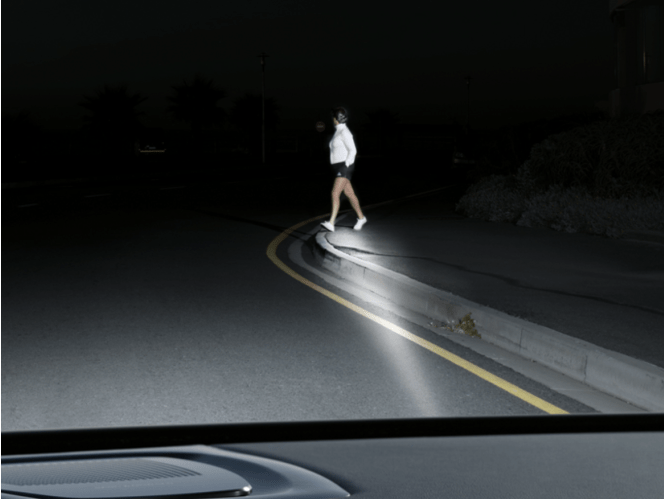Automatic braking systems aren't reliable on unlit roads where more than one-third of all walking deaths currently happen, according to a new study the comes out just weeks after the feds said they would pursue new rules to put such pedestrian detection and braking systems on all new cars — and they don't work well at the deadliest speeds, either.
In an analysis of more than 1,500 real-world crashes involving vehicles equipped with the tech across America, the Insurance Institute for Highway Safety found "no difference in the odds of a nighttime pedestrian crash for vehicles with and without the crash avoidance technology" in areas not equipped with working street lighting.
According to the National Highway Traffic Safety Administration, a whopping 34 percent of pedestrian deaths happened on unlit roads at night between 2015 and 2019. Of those deaths, about 65 percent occurred in urban areas, rather than in rural areas (35 percent) with which streetlight-free roads are more commonly associated.
The good news: automatic emergency braking did cut the odds of a pedestrian crash by about 32 percent in daylight, and 33 percent on well-lit roads after dark.
But those benefits vanished as drivers sped up: there was "no reduction at all" on roads with speed limits over 50 miles per hour, a threshold above which walkers die more than 75 percent of the time.
The Institute confirmed those findings in off-road tests of eight vehicles, which also revealed that good headlights couldn't compensate for poor streetlights, and that radar-equipped vehicles, which don't depend on light to "see" the road, didn't identify pedestrians any better than cars with cameras alone.
"It’s a great reminder of the fact that the vehicle is just one part of a safe system," said Jessica Cicchino, vice president of research for the Institute. "This technology can save lives, but we still need to focus our attention on improving all parts of the system at the same time."
.@IIHS_autosafety found that carmakers' pedestrian detection systems made "no difference" at night -- when 3/4 of pedestrian deaths occur.@USDOT's new roadway safety strategy calls for mandating pedestrian AEB. We need tough performance standards, too.https://t.co/v7A3rl2hWK
— David Zipper (@DavidZipper) February 3, 2022
The study is a timely reminder that today's automated vehicle technology is not a silver bullet for America's roadway safety woes — and of how critical street lighting is for walker-friendly road design, whether software or a human driver is controlling the brakes.
Actually illuminating more U.S. roads, though, will be a challenge. Few municipalities conduct regular audits of their street light networks, and when they do, they often focus on reducing "unnecessary" lamps that the city is obligated to power; others remove lights out of concern for excessive light pollution, which can disturb the natural rhythms of humans and wildlife, particularly if lamps aren't "shielded" to direct the beam towards the ground rather than the sky.
Even among the street lamps that make the cut, maintenance still can be a challenge. When Detroit filed for bankruptcy in 2013, for instance, officials famously estimated that more than 50 percent of the Motor City's 88,000 streetlights were non-operational, plunging whole blocks into total darkness. (Transportation for America ranked it the 11th most dangerous U.S. metro for pedestrians the next year; Detroit has fallen 20 spots down the list in the years since the city began replacing broken lights with LEDs.) A 2019 study of Austin, Texas' West Campus neighborhood, meanwhile, found that 8 percent of lights were obstructed by trees and other objects, and another 10 percent weren't working for other reasons the auditors couldn't determine, underscoring the challenges of shining a light on every possible car crash site.
In its new National Roadway Safety Strategy, NHTSA pledged to "incorporate lighting into Complete Streets implementation so that lighting becomes a key design factor in roadway upgrades," which advocates regarded as a positive first step. That guidance, though, won't light up every U.S. street overnight — and in the meantime, automatic emergency emergency braking systems won't be much help to pedestrians on the ones that stay dark.
That's not to say, of course, that automatic pedestrian detection systems aren't a worthy effort that will save lives in many roadway scenarios — or that DOT shouldn't be applauded for including them in their upcoming rule-making. To make that move truly meaningful, though, Cicchino says that it's critical that NHTSA develop performance standards to measure how well the tech works at all times of day, and make sure consumers are aware of when they can — and can't — trust their car to save pedestrian lives.
"We’ve known for a long time that vehicle-to-vehicle automatic emergency braking is highly effective at reducing rear end crashes," added Cicchino. "And it's a promising countermeasure for pedestrian crashes, too...[but] all forms of drive assistance have their shortcomings."






